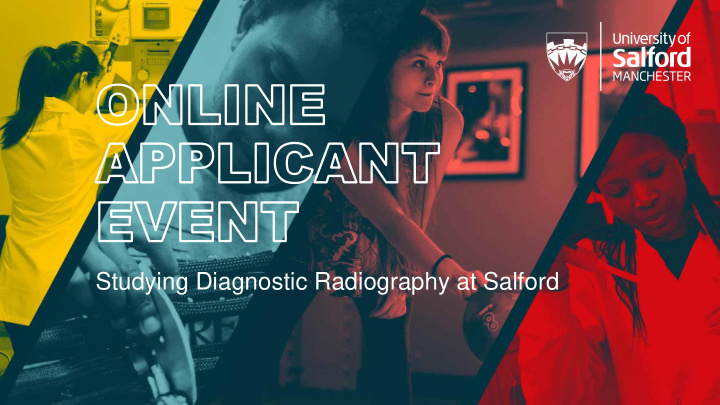



Studying Diagnostic Radiography at Salford
Welcome!
Overview of the morning. • Course information • Example of a teaching session – Communication • Q and A with Diagnostic Radiography staff
Radiography at the University of Salford • BSc (Hons) Diagnostic Radiography • 3 Years – 6 Semesters • 50% Clinical • 50% Academic
Our Team • Academic • Dedicated Clinical Skills Team • Clinical Tutors • Close links with clinical placements • Different specialisms • Research active
Programme Content • Throughout your journey on the programme, you are supported by a dynamic and award-winning team. • Our three year programme includes all of the fundamental elements of radiographic practice including anatomy and physiology, radiographic science and technique. • As an active research department, you will also be involved in research activity in all three years of the programme.
Programme Content • YEAR 1 • Introduction to Collaborative Professional Practice (Diagnostic Radiography) • Scientific Principles for Diagnostic Radiography • General Radiography I • Fundamentals of Patient Centred Care • General Radiography II
Programme Content • YEAR 2 • • Screening, Diagnosis and Intervention I • Applied Radiography I • Research Methods • Screening, Diagnosis and Intervention II • Applied Radiography II • Introduction to other imaging modalities
Programme Content • YEAR 3 • • Trauma Imaging • Into Employment • Radiographer Commenting • Compassion, Professionalism and Employment • Applied Research Methods • Competent Professional
Our Clinical Facilities • 2 Digital X-Ray Rooms • CT Scanner • Ultrasound Simulators • Anatomage interactive anatomy table
Our Clinical Facilities • Used by the students throughout their three years • Year 1 & 2 – Dedicated clinical skills teaching • Year 3 – Research Projects
Attendance Pattern – Trimester 1
Attendance Pattern – Trimester 2 •
Attendance Pattern – Trimester 3
Our Teaching Methods • Problem Based Learning • Simulation • Workshops • Lectures • Tutorial • Practical skills sessions • Learning through play • Service user involvement
Methods of Learning – Problem Based Learning (PBL) • Student-centred learning • Small group work • Given weekly trigger/problems • Students create learning objectives • Fixed resources (lectures and tutorials) to support each week’s trigger
Assessment Methods • OSCE • OSE • Presentation • Interviews • Leaflet • Written Assignment • Reflection • Summative Clinical Assessments
Clinical Education • Underpinning academic learning • Clinical practice • Use a range of hospitals/placements • Clinical simulation • Work closely with clinical staff
Clinical Placement Education • AIM • To enable the student to develop, apply and evaluate the professional skills, attitudes and behaviors that are essential for safe and effective practice
In other words…….. • We give you the opportunities and experience to prepare you to: • Become a competent radiographer • who is able to work: • in a range of hospitals and clinical situations • with confidence and proven ability
What else we give you • Opportunity: • to work as part of a dedicated team of professionals • to work with advanced and consultant practitioners with specialist skills • to gain clinical skills in addition to radiographic skills • to gain an understanding of the management of a radiology service • for elective placements • to be involved in cutting edge radiography research
Our Placement Hospitals Blackburn Bolton Fairfield North Wigan Oldham Manchester Infirmary Salford Tameside X MRI Royal Trafford Stepping Hill Wythenshawe Macclesfield
Placement Clusters • For some of the clusters a rotation will still be necessary. • This is to gain all the experience needed as not every site offers all experiences.
Clinical Placement - The Hours • Radiology department working hours are rarely 9am-5pm and most practice extended regular working hours as well as a limited service 24 hours a day. • In the 2nd and 3rd years you may need to work more flexible hours depending on the practical experience you require at the time. You are also offered the opportunity to work night shifts. • -1st year • 9 - 5pm working day • (1/2 hour lunch = 3o hours per week) • Actually allocated 30 clinical practice hours each week • + Study time
How will I know how I am doing? • You will complete a range of formative and summative assessments • These measure your competency and learning across a range of relevant to your level of study • The feedback you receive will help you to formulate learning objectives for your continued development and prepare for career as a radiographer.
Our contact details • If you have any questions please e-mail Radiography admissions: • Healthcare-RadiographyAdmissions@salford.ac.uk
And finally….. • Follow us on Twitter - @salfordrads
To see what other presentations are available today, please go back to our event hub
Recommend
More recommend